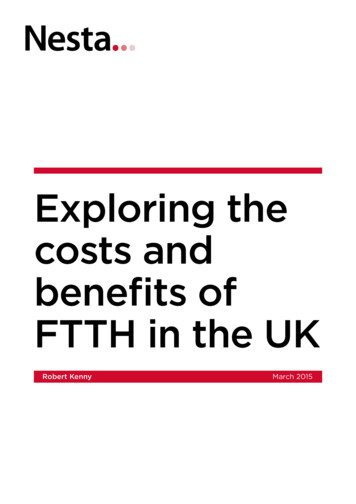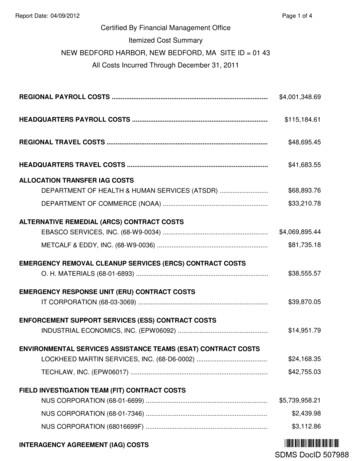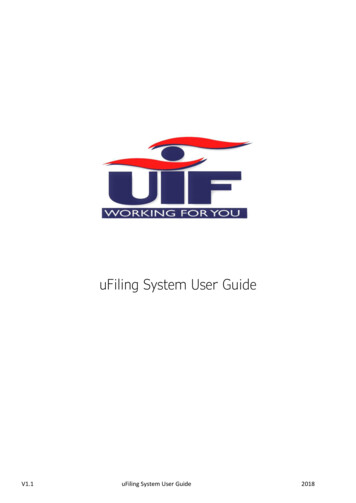
Transcription
Exploring thecosts andbenefits ofFTTH in the UKRobert KennyMarch 2015
2Exploring the costs and benefits of FTTH in the UKCONTENTS1.EXECUTIVE SUMMARY32.INTRODUCTION43.BENEFITS OF FASTER BROADBAND74.5.6.7.Economic Impact of FTTH broadbandEconomic impact of faster broadbandBandwidth demand forecastsBandwidth demand compared to access network capabilities78910THE COSTS OF FTTH DEPLOYMENT11Variation in FTTH deployment costFTTH Cost estimatesSummary111213THE DYNAMIC INVESTMENT DECISION13The recent roll–out of FTTCApplication developmentAccess technology developmentPromotional value‘Future proof’ investmentsLead timesRegulatory issuesConclusion1416171919192020POLICY RECOMMENDATIONS21ExperimentationInformation gathering2122APPENDIX: BROADBAND INFRASTRUCTURE EXPERIMENTS23FTTH Cost estimates24ENDNOTES26DisclaimerThe opinions offered in this report are purely those of the author. They do not necessarilyrepresent the views of Nesta, nor do they represent a corporate opinion of CommunicationsChambers.
3Exploring the costs and benefits of FTTH in the UK1. EXECUTIVE SUMMARYAs a result of both purely commercial roll–outs and government intervention,by 2015 95 per cent of the UK will have access to ‘fibre to the cabinet’ (FTTC)broadband, providing average speed of 42 Mbp.1 Virgin’s cable network offerseven higher speeds to 50 per cent of the country today, and this is set to increase totwo–thirds.2However, a number of countries, particularly in East Asia, have built out ‘fibre to the home’(FTTH) networks which can deliver speeds of 1 Gbps or more. There are now approximately 130million FTTH connections worldwide.3 Some argue that the UK government should intervene toencourage nationwide FTTH here.One challenge in making this case is that, to date, there is little evidence on the benefits ofFTTH over FTTC, and in particular of the public benefits which might justify market intervention.This may conceivably be because it is too early for such benefits to have materialised. But theresult is that the case for public investment in FTTH has to be on more speculative grounds – forexample, based on the possibility of a new killer application requiring speeds only FTTH provides(one version of the ‘future proof’ argument), or on non–economic grounds altogether.This is doubly so since all three published forecasts of UK bandwidth demands we discuss inthis report suggest that FTTC will provide ample bandwidth for many years to come. Some non–UK forecasts anticipate demand for higher speeds, but still well within the capability of G.fast(the next generation of copper technology, which BT currently expects to deploy starting in2016/17),4 suggesting that FTTH is not essential even to meet these forecasts.The justification for investment in FTTH needs to be strong, since it is an expensive upgrade.Based on UK and international cost studies, the cost of a UK nationwide roll–out might beapproximately 25 billion (though this could be reduced appreciably if a narrower coveragetarget was used). Such an investment in nationwide roll–out would be very difficult to justifycommercially, since there is little evidence that consumers are willing to pay a premium forthe extra speed FTTH brings. Consequently, even if the government were to just provide ‘gap’financing, it might need to cover a substantial portion of this cost.It is important to note that decisions about broadband infrastructure are not ‘for the ages’ –rather they sit in a dynamic environment with irreversible investments and great uncertaintiesabout new access technologies and new applications. This suggests that the optimal ‘futureproof’ strategy may actually be one of strong ‘watching brief’, to monitor for developingopportunities.Thus policymakers need to consider: Research into the usage patterns of households moving to higher speed connections,to understand if this results in changed behaviour and in particular increased usage ofapplications with positive externalities. Investigation of the applications in use in countries with widespread FTTH, to see if thatinvestment has paid national dividends.
4Exploring the costs and benefits of FTTH in the UK Demonstrators, perhaps focused on areas of the UK which already have material FTTHor creative and digital clusters where businesses are arguably best placed to exploithigh speeds, to see if there is the opportunity for business and civic applications builton this infrastructure. One or more national laboratories, similar to Australia’s Institute for a BroadbandEnabled Society, focused on socially valuable applications of a higher speed internetwhich might not be purely commercially justifiable.2. INTRODUCTIONSince the advent of dial–up there have been numerous generations of internetaccess technologies. These have brought faster speeds as well as otherbenefits such as greater reliability and lower latency.FIGURE 1: SELECT BROADBAND TECHNOLOGIES5TypeNetworkTechnicalStatusTypical speedDial-upCopperObsolete56 KbpsADSL 2 CopperLiveUp to 20 MbpsFTTCFibre CopperLiveUp to 80 MbpsHFCFibre CableLive150 MbpsG.fastFibre CopperField trials700 MbpsXG.fastFibre CopperLab trials1 GbpsFTTHFibreLive1 GbpsMost broadband users around the world are on connections that make at least some use ofthe historic copper networks (both telephone and cable TV). Technologies such as ADSL(asymmetric digital subscriber line), FTTC and HFC (hybrid fibre coax) all rely in whole orin part on existing networks.In the UK BT has been investing 2.5 billion in FTTC.6 In addition, 1.2 billion of governmentfunds have been provided to support roll–out in areas where it would not otherwise becommercially viable.7 As a result, FTTC coverage now reaches 21 milion premises.8 (Afurther 500 million of government funding is pending to increase coverage to 95 per centof homes).
5Exploring the costs and benefits of FTTH in the UKEven in rural areas, FTTC currently provides average speeds of 40.8 Mbps,9 and urban consumersaverage 49.8 Mbps. Virgin Media has continued to invest in its own HFC network, and now offersspeeds of 150 Mbps to consumers within the 50 per cent of the country it covers. Overall (inpart thanks to existing government interventions), superfast broadband coverage of 30 Mbpsor better is expected to reach 95 per cent of households by 2017.10 Much higher speeds will beavailable to most households. By 2020, Virgin will increase its coverage to 17 million premises, orapproximately two-thirds of the country.11 BT says that it “expects to offer initial speeds of a fewhundred megabits per second to millions of homes and businesses by 2020” using G.fast.12However, some countries – notably Japan, Korea, China, Hong Kong, Singapore, Qatar and NewZealand – have invested substantially in FTTH, which entirely replaces legacy copper. This canenable very high speeds (typically up to 1 Gbps, and potentially even more), provide low latencyand reduce operating costs, albeit at a substantial upfront cost.These international investments are not necessarily a model for the UK however – the socialand economic benefits they have delivered are not yet clear. Moreover, they were in part drivenby circumstances of time and place. Singapore and Hong Kong have very high populationdensity, which greatly reduces the costs of FTTH. Japan and Korea made their FTTH investmentdecisions long before cheaper, copper–based superfast broadband technologies were available.China is rolling out FTTH primarily in ‘green field’ sites where it is a natural choice.That said, some argue that the UK should be making similar investments in FTTH. For instance,Labour Digital has recently proposed that “The UK should target nationwide access to 1 Gbpsbroadband in homes, businesses and public buildings, with 10 Gbps services for tech–clusters, asearly as possible in the next parliament.”13This paper: Reviews evidence14 on the benefits and costs of such an investment. Discusses the dynamic nature of the investment decision, and highlights issues which couldchange the optimal approach over time. Considers the implications for policy.
6Exploring the costs and benefits of FTTH in the UK3. BENEFITS OF FASTERBROADBANDWhile there is copious analysis on the economic and social benefits ofbroadband, there is far less that looks specifically at the benefits of greaterspeed. Analysys Mason, in a 2013 report on the benefits of broadband for theEuropean Commission, commented:Over 200 previous studies and reports were examined for the literature review. Most of the literature that exists does not consider high–speed broadbandexplicitly (only 11 per cent mentioned high–speed broadband) and very littlehas been written about the incremental benefits that result from having high–speed broadband as opposed to lower speeds.15While there is little analysis of the benefits of higher speed broadband, there is even less onthe merits of different varieties of higher speed – for instance, the benefits of 1 Gbps FTTHbroadband over those from 80 Mbps FTTC broadband.In this section we present the results of a number of studies that do look at the economic andsocial benefits of speed, starting with those looking specifically at FTTH, before moving to moregeneral discussions of speed.16A fundamental challenge faced by empirical work in this area is that the benefits of increasingavailable speed very much depend on current capacity: doubling speed from, say, 1 Mbps to2 Mbps might bring substantial benefits, but this may be a poor indicator of the benefits fromdoubling from 100 Mbps to 200 Mbps. For instance, an Ofcom analysis of the relationshipbetween ADSL line speed and consumer traffic found that while traffic grew steeply as linespeed increased from 0 to 6 Mbps, at 8–10 Mbps consumption plateaued – additional speedbeyond this brought very little additional usage.17 (Note that this analysis primarily addressedconsumers – results for business customers could well be different).To take a parallel from electricity, a country suffering regular black–outs and brown–outs wouldclearly benefit from increased generation capacity, but for a country without such problemsinvestment in capacity may be money wasted.A critical consideration therefore is whether demand outstrips supply. We therefore concludethis section with a summary of the small number of reports which have considered futuredemand for bandwidth, though we note that these generally do not attempt to address currentlyunknown services which may require even higher speeds.
7Exploring the costs and benefits of FTTH in the UKEconomic Impact of FTTH broadbandReportAuthorsDateMethodologyKey finding/claimCommentEarly Evidence SuggestsGigabit Broadband DrivesGDPAnalysis Group for FTTHCouncil2014Fixed effects panel data regressionmodel of selected US regions withand without 1 Gbps broadband1.1 per cent uplift to GDP in USregions from 50 per cent availabilityof 1 Gbps broadbandUnclear how reverse causation hasbeen corrected for (ie gigabitinvestment focused on high growthmarkets).Availability rather than adoption usedResult not significant at 5 per centlevelIndependent cost–benefitanalysis of broadband andreview of regulationOptimal Investment inBroadband: The Trade–OffBetween Coverage andNetwork CapabilityVertigan Panel forAustralian GovernmentRobert Kenny (presentauthor) for Vodafone20142010Cost–benefit analysisFTTH–heavy national broadbandnetwork (NBN) would destroyA 1,600 of value per Australianhousehold compared to a plan withmore FTTCReview of applicationsVast majority of applications withexternalities are possible with 24Mbps or less. Only exception ispotential educational virtual realityModelling of consumer willingness–to–pay and costs by geotype fordifferent BB techs to derive requiredexternalities to justify publicinterventionA belief in extremely high incrementalexternalities for FTTH over FTTC isrequired to justify policy support forFTTHCommissioned by new governmentwith stated policy to shift NBN froman FTTH heavy approachAnalysis based on initial availability ofbasic BB only – even higherincremental externalities for FTTHrequired if FTTC already rolled out
8Exploring the costs and benefits of FTTH in the UKEconomic impact of faster broadbandReportAuthorsDateMethodologyKey finding/claimCommentSocioeconomic effects ofbroadband speedEricsson, Arthur D. Littleand Chalmers University ofTechnology2013Propensity Score Matching analysis ofinternational consumer research dataIncreased broadband speed benefitshousehold income, but no significantbenefits beyond 8 Mbps (in OECDcountries)Methodology cannot rule out reversecausality.Does broadband speedreally matter for drivingeconomic growth?Rohman & Bohlin, ChalmersUniversity2012Cross country analysis of OECDcountries, 2008–10Doubling speed adds 0.3 per cent toeconomic growthSample mean bandwidth was 8 Mbps– unclear if relationship holds forincreases from higher speedsUK Broadband ImpactStudySQW for DCMS2013Modelling based on assumed deltain broadband speed take–up and theRohman & Bohlin analysis of benefitsof speedCurrent UK government interventionsfor faster broadband will add 6.3billion p.a. of GVA, and return 20 per 1 investedCritically dependent on applyingRohman and Bohlin’s estimates ofmarginal benefits of faster broadband speed at 8 Mbps to much higherspeed rangesMyths and realities aboutthe UK’s broadband futureEIU for Huawei2012Qualitative discussion based oninterviews and literature reviewConstruction of superfast will bringeconomic benefits, but longer termbenefits contingent on institutionalchange, skills and so onFocused on FTTC – no discussion ofincremental benefits of FTTHImpact of Broadband onthe EconomyITU2012Survey of econometric studiesNumerous studies point to economicbenefits of broadband, but littleevidence to date re benefits of fasterspeedsSuperfast Cornwall UpdateReportSERIO2014Survey of businesses using superfastin Cornwall 99 million GVA expected to becreated by superfast programmeSuperfast – Is it worth asubsidy?Kenny & Kenny2011Literature review and analysisWide range of externality–generatingapplications (e–health, e–government,smart grids and so on) do not requiresuperfast speedsEarly effects of FTTH/FTTxon employment and population evolutionForzati & Mattsson2012Multivariate regression of SwedishmunicipalitiesFinds weak correlations suggesting 10per cent increase in FTTH/B coveragein a municipality increases populationby 0.25 per cent and employmentbetween 0 and 0.2 per centPublic Private Interplayfor Next Generation Access Networks: Lessonsand Warnings from Japan’sBroadband SuccessKenji Kushida (StanfordUniversity)2013Review of Japan FTTH deployment“taking advantage of the broadbandenvironment to produce innovation,productivity growth, and economicdynamism, was far more difficult thanfacilitating its creation”Superfast Cornwall includes bothFTTC and FTTP. Survey did notdistinguish between the twoLimited overlap of FTTH with FTTC orHFC, so study is effectively ofsuperfast vs basic broadband
9Exploring the costs and benefits of FTTH in the UKBandwidth demand forecastsReportAuthorsDateMethodologyKey finding/claimCommentDomestic demand forbandwidth18Communications Chambersfor BSG2013Bottom–up analysis based onapplication bandwidth requirements,usage trends household size andprobabilistic analysis of simultaneoususeIn 2023 the median household willhave a requirement for 19 Mbps, top 1per cent will need 35–39 MbpsBased in part on proprietary datafrom UK ISPs. Currently unknowntypes of application not includedMarket potential forhigh–speed broadbandconnections in Germany inthe year 2025WIK for FTTH Council2013Bottom–up analysis based on application bandwidth requirements andindividual and SME usage profiles.Methodology for aggregatingHH usage unclear60–350 Mbps downstream required in2025, with near symmetric upstreamrequirementsSome assumed applicationrequirements seem very high(e.g. 25 Mbps for HD communicationsvs 2 Mbps per Skype, Apple)100 Mbps for each of cloud servicesand home working a criticalassumption – note that homeworking and cloud services are bothwidespread today at far lower speedsHow the speed of theinternet will developbetween now and 2020Dialogic and TUE forNLkabel & Cable Europe2014Application–based traffic forecastwith assumption that bandwidthrequirement grows pro–rata to trafficAverage user needs 165 Mbps downand 20 Mbps up in 2020No evidence offered for critical‘pro rata’ assumption19Can you ever have enoughbandwidth?BT2014Bottom–up based on applications andexemplar household and usagepatterns95 per cent of households will needless than 35 Mbps in 2018Limited information on details ofmethodologyInternational benchmark ofsuperfast broadbandAnalysys Mason for BT2013Bottom–up analysis based onrepresentative sample of householdtypesTop 1 per cent of UK households willneed 52 Mbps in 2018
10Exploring the costs and benefits of FTTH in the UKBandwidth demand compared to access network capabilitiesAs we have seen, forecasts for bandwidth demand have a wide range. However, they are allconsistent in suggesting that needs for some years ahead at least will be well within the range ofcopper technologies.For example, the WIK forecasts (on behalf of the FTTH Council) are the most aggressive, buteven these suggest that needs in 2025 will be well within the capabilities of G.fast which hassignificantly lower cost than FTTH. See page 23 below for a more detailed discussion of G.fast.FIGURE 2 BANDWIDTH DEMAND FORECASTS AND NETWORK CAPABILITIES201000FTTHWIKG.fast (BT plan)DialogicMbps (log scale)100FTTCAnalysys MasonBSGBT10201520172019202120232025
11Exploring the costs and benefits of FTTH in the UK4. THE COSTS OF FTTHDEPLOYMENTVariation in FTTH deployment costThe cost of FTTH deployment depends on a wide range of factors. These include: National labour costs. The biggest cost component of FTTH is ‘civils’ (installing fibre in theground and into the home) which can represent 80 per cent of the total.21 This cost sees onlymoderate benefit from technology development,22 and is primarily driven by labour costs. Population density. Areas with denser population are cheaper to serve, since civils costs perhousehold are lower (because fibre lengths are shorter). Population density is a factor bothwithin countries and between countries. Scope. The importance of population density means that the scope of an FTTH roll–out is animportant factor in costs per household. Higher percentage coverage will come at a higherunit cost, since more sparsely populated geographies are included. Analysys Mason estimatethat providing FTTH to ‘the last 20 per cent’ of homes in the UK would cost roughly as muchas providing it to all of the other 80 per cent in more densely populated areas.23 Existing assets. The availability of capacity in existing ducts can reduce deployment costs.(Note that different countries have very different starting points in this regard.) The party undertaking the deployment. Generally the incumbent has advantages both inaccess to existing assets such as ducts and in a large and experienced workforce, reducingcosts. The nature of building stock. Multiple dwelling units (apartments) can be cheaper to serve,though vertical risers (ducts) and building owner permissions can be challenging. Older orhistoric buildings can be problematic, because new in–home wiring may be required. Set–backs from the curb also increase costs. Greenfield vs brownfield. For new developments, the cost of FTTH is generally similar tocopper, since new ducts and cables must be deployed in either case. However, it is generallymuch more expensive for existing properties (where the copper is already in place, but fibremust be newly laid).Thus any estimate of FTTH deployment costs needs to be seen with these variations in mind – inparticular, deployment costs in developing markets may not carry over to developed markets;the level of coverage is a key variable, and so on. With these caveats in mind, we provide arange of FTTH deployment cost estimates. Estimates for other countries we have scaled forUK population to provide a crude proxy for equivalent UK costs. A number of estimates are forcost per household, often for particular geotypes. Given the wide variation in costs for differentgeotypes, we have not scaled these to a UK national figure.
12Exploring the costs and benefits of FTTH in the UKFTTH Cost estimatesReportAuthorsDateScope and CoverageEstimated cost (and equivalent)20The costs of deployingfibre–based next–generation broadbandinfrastructureAnalysys Mason (for BSG)212008UK (split by geotype) 25 billion for national coverage, 13 billion for 80 percent coverageBusiness Plan V5.2B4RN2013UK rural roll–out 1,116 per home (assuming 100 per cent take–up)Innovative FTTHDeployment TechnologiesFTTH Council2014Parham village, UK. (‘Tractor broadband’ using localagricultural contractors) 2,000 per homeSzenarien und Kostenfür eine kosteneffizienteflächendeckendeVersorgung der bislangnoch nicht mit mind. 50MBit/s versorgten RegionenTÜV Rheinland (for Germangovernment)2013Germany, nationwide 85.5 – 93.8 billion [ 53–58 billion for UK]The Cost of NationwideFibre Access in GermanyWIK2012Germany, nationwide 70 – 80 billion [ 43–50 bilion for UK]A cost effective topologymigration path towardsfibreFrank Phillipson, TNO[Netherlands Organisationfor Applied ScientificResearch]2013Urban Netherlands 968 [ 545] per connectionModification anddevelopment of the LRAICmodel for fixed networks2012–2014 in DenmarkTera Consultants (forDanish Business Authority)2013Denmark national coverageDKK32.7 billion [ 39 billion for UK]The Italy and Spain NGAcases from a commercialand regulatory point of viewAnalysys Mason2013‘Western European Country’ (with 20–25 per cent ofpremises in MDUs, 33 per cent uptake) 2,300 [ 1,400] per connectionCosts of deploying FTTdpwith G.fastHuawei2014Generic model for ‘European country’Per home connected (with 60 per cent market share):Urban 2,100 [ 1,300], Suburban 3,300 [ 2,100], Rural 5,000 [ 3,100]NBN Co Strategic ReviewNBN Co201393 per cent coverage for AustraliaA 38.2 billion [ 57 billion for UK]Connect America CostModel OverviewFCC2013Cost model for US carriersApprox 1,300 [ 800] per premise passed investmentcost for major carriers (higher for those in more rural areas)Why Are You Not GettingFiber?Calix2010Cost for Verizon (in their selected roll–out areas) 700 per home passed plus 650 per home connected[ 440 410]
13Exploring the costs and benefits of FTTH in the UKSummaryTotal costsThe Analysys Mason estimates are the only ones we have been able to identify that quantifycosts for a national or near–national UK roll–out of FTTH. Their 2008 estimate of 25 billion isstill widely cited.In general, scaling other European estimates (such as those for Germany and Denmark) for UKpopulation arrives at appreciably higher figures that those from Analysys Mason.For the 26 million UK households, Analysys Mason’s 25 billion estimate implies a per–householdcost of 962. This is in the range of the 545 to 2,000 per–household costs set out above for avariety of different geotypes.Gap financeThe figures above are for the total cost of FTTH deployment. It is at least feasible that thesubsidy required to enable FTTH roll–out could be considerably lower. Countries such asMalaysia, New Zealand and France have taken this approach, providing funds to operators(primarily incumbents) to support but not fully fund FTTH. One guesstimate for the UK(the basis for which is not provided) suggests that 3 billion of public funds could trigger anationwide roll–out.26However, this figure seems optimistic. Gap finance at any moment in time is only viable if theincremental investment solely funded by the commercial sector is anticipated to generatecommensurate incremental revenue or cost savings. However the evidence suggests thatconsumers currently have a low willingness–to–pay for the additional speed and lower latencyoffered by FTTH27 and thus the market case is doubtful. FTTH does bring some operational costsavings over FTTC, but given the small portion of total costs represented by opex (typically 5 percent or less of the capital cost),28 this isn’t generally significant.Thus in the UK context, it is unclear that the private sector would be able to capture materialextra revenues from the at least 22 billion they would be required to fund, even after 3 billionof gap funding. Just the 22 billion would be nine times the 2.5 billion BT is investing in FTTC.Consequently, necessary gap funding for FTTH is likely to be substantially greater than 3 billion.5. THE DYNAMIC INVESTMENTDECISIONTo date the UK has focused primarily on FTTC, both commercially and as a matter of governmentpolicy. (Though as we have noted, Virgin offers cable broadband to approximately half thecountry and expects to increase this to two-thirds, and BT expects to deploy G.fast. There arealso some local investments in FTTH –see Figure 3).
14Exploring the costs and benefits of FTTH in the UKToday’s available evidence (as set out in the preceding sections) certainly suggests that atraditional cost–benefit analysis would not support intervention for an alternative, FTTH–focusedapproach.FIGURE 3 SAMPLE UK FTTH DEPLOYMENTS29HyperopticSky / Talk Talk / City FibreGigaclearOffers FTTH to select residentialThe three companies are planningOperates nine local networks indevelopments, targeting thosea joint roll-out of FTTH to ‘tens ofrural areas, with plans to reachwhere it will have low unit coststhousands’ of homes in York, to200,000 homes. Secures minimumand good prospects for demandlaunch in 2015.volume commitments from(in part because they are incommunities before deploying.locations with poor BT connectivity).Plans to pass 0.5m homes by 2018.However, given the fast–changing nature of the market, the evidence base will develop and it isappropriate to keep under review the potential returns from an FTTH investment.This section explores some of the market developments that have and will in the future influencethe merits of intervention in support of FTTH. We consider: The impact of the recent roll–out of FTTC. Application development. Access technology development The ‘promotional’ value of gigabit speeds. FTTH’s case to be ‘future proof’. Lead times. Regulatory issues.The recent roll–out of FTTCThe trade–offs of an FTTH investment for the UK are now very different from the way theywere at the time of Stephen Carter’s Digital Britain Review five years ago. At that time, the UKhad solid basic broadband, but limited faster broadband. Virgin was the only network offeringgreater than DSL speeds, but this offer was not at today’s speeds of up to 152 Mbps, and waslimited to half the country.Thus in 2009 FTTH (and indeed FTTC) would have brought a substantial uplift in availablecapacity. In choosing whether to invest in the cheaper option of FTTC or instead to prefer FTTH,the critical question was whether the incremental benefits for FTTH was more or less than theincremental cost (Figure 4). At the time the general (though certainly not universal) consensuswas that the incremental benefits of FTTH were less than the incremental costs, primarilybecause of the much higher costs of an FTTH solution.
15Exploring the costs and benefits of FTTH in the UKFIGURE 4 ILLUSTRATIVE ‘2009’ INVESTMENT CHOICEIncremental benefits of FTTHVSFTTH FTTCFTTHIncremental costs of FTTHFTTCBenefitsCostsThe question remains today whether a widespread FTTH roll is justified. However, the investmentchallenge for FTTH is now significantly harder, because since 2009 the UK has seen theupgrades to BT and Virgin’s networks. The cost of these upgrades are sunk, and thus are mostlyirrelevant to current decision making. (A portion of the FTTC network will be redeployable forFTTH, however, reducing its net cost).Consequently, whatever incremental benefits FTTH brings must be compared to the total cost ofFTTH roll–out (net of redeployed FTTC), not just the incremental cost over FTTC. (We use FTTCas an illustration – similar logic applies to HFC).
16Exploring the costs and benefits of FTTH in the UKFIGURE 5 ILLUSTRATIVE ‘2014’ INVESTMENT CHOICEIncremental benefits of FTTHVSFTTH FTTCFTTHTotal costsof BenefitsCostsTo take a parallel, it is currently being debated whether London’s next runway should be atGatwick or Heathrow. Whatever decision is made, clearly once one such runway has been built, itwould be hard to immediately justify also building another runway at the other airport.If we take into account the announced plans of BT and Virgin, then the case for governmentintervention for FTTH becomes harder to make. Since both companies are deployingtechnologies with far greater capabilities than FTTC, the incremental benefit of FTTH becomeseven smaller.Application developmentAbsence of a ‘killer app’ for FTTHWith the passage of time we have increasing information on both new applications and usageof new and old applications. A ‘killer app’ for FTTH has not yet appeared. (This is not for lackof an addressable market – as noted earlier, there are already approximately 130 million FTTHconnections worldwide).30Ovum has spoken of an ‘application vacuum’, which “provides a reason as to why the uptakeof fiber services has been muted and telcos are reluctant to move aggressively to FTTH”.31According to Heavy Reading in a recent presentation for the FTTH Council, “No singleapplication requires FTTH – and there’s little sign of such an application is emerging”.32 (Whilepresentations for the Council in prior years had acknowledged the absence of a single killer app,the statement that there was no sign of one emerging was new in 2014.)The respected Pew Research Centre recently published a report Killer Apps in the Gigabit Age,based on consultation with numerous internet experts.33 Strikingly, the applications identified do
broadband, providing average speed of 42 Mbp.1 Virgin's cable network offers even higher speeds to 50 per cent of the country today, and this is set to increase to two-thirds.2 However, a number of countries, particularly in East Asia, have built out 'fibre to the home' (FTTH) networks which can deliver speeds of 1 Gbps or more. There are now approximately 130 million FTTH connections .











